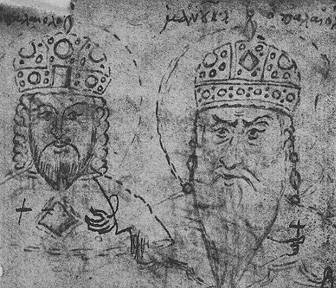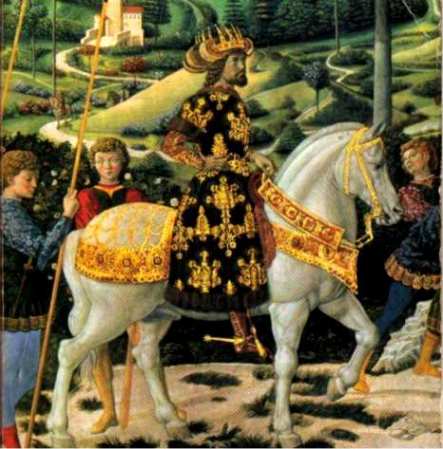.
Manuel II Palaeologus (1350 - July 21, 1425) was intellectual, soldier, statesman, and Byzantine emperor (1391-1425).
He was son of John V Palaeologus, and when his
father died, in February 1391, he escaped fron the turkish camp where he was kept as prisoner, and came to Constantinople to regain his throne
(he had been crowned co-emperor in September 1373). The situation of the Greek Empire was desperate. Turks had conquered
most of the byzantine provinces, had devastated and pillaged the big cities and had enslaved thousands women, young boys and
girls. Manuel was forced to pay tribute to the Sultan Bayezid and was forced to follow him to his raids against the Greek
cities. His chagrin was strong when he observed the Ottomans destroy and plunder the cities of
Euxenus Pontus (Black Sea) and other cities of
Minor Asia.
When he asked Turks the names of christian cities that were pillaged and devastated, he received the answer:
"the way we destroy them their name is also disappearing from earth...".
In 1392 he married Helena Dragases, daughter of the Serb Despot Constantine Dragases. The ceremeny of the marriage
took place in the church of
Aghia Sophia
and Helena was crowned empress by the Patriarch Antonios. The magnificent ceremenoy
with all the details of the byzantine protocol has been saved by the Russian sightseer Ignatius.

In 1394, the Sultan with his army laid siege to Constantinople and this blockade was to last eight years, bringing
despair and hunger to the population of the city. In 1396 the united christian forces of Europe under the leadership of the
king of Hungary Sighismund, in an effort to drive away the Turkish invaders from Europe, were defeated in the battle of
Nicopolis. Thousands of Franks, Germans, Italians, Polish were killed, all the prisoners were slaughtered and
Turks were free to pour south. They overran Thessaly and the Peloponnese and in their usual way they ravaged and
devastated the territories they crossed through. According to the historian Donald Nicol, the city of Argos
of 30000 inhabitants was totally eliminated and all population was perished.
In 1396, Manuel made a journey to western Europe to appeal for help. He was graciously received in Rome, Milan, London,
and Paris; he stayed in the french capital for two years. His visit did much to promote cultural ties between Byzantium
and the West, but military aid was not forthcoming. As the historian Runciman describes "the french and english
aristocracy received the king of Greeks with honor and respect and the intellectuals were happy to exchange views
with such a sophisticated and educated person. They had already come in acquaintance with the classical greek studies
thanks to
Chrysoloras Manuel
who was a pioneer in spreading Greek literature in the West."
Manuel was in France, 28 July 1402, guest of the kig Charles VI, when he received the good news of Bayezid's debacle
by the Mongol conqueror Tamerlane, in the famous battle of Angyra (Ankara). Manuel returned to
Constantinople and with skillful diplomatic tactics he stimulated the civil wars between Bayezid's successors.
He first supported Suleyman, who fought his brother Musa, and recovered Thessalonica, the capital of
Macedonia,
Mount Athos,
Mesimvria, some cities of
Euxenus Pontus,
putting an end to tribute payments.
But Musa finally defeated his brother Syleyman in Adrianople and later he strangled him, as it was the ottoman custom
for the successors of the throne who were captured alive.

Now Musa turned against the Greeks. The Ottomans poured in Thrace and Macedonia pillaging and burning villages and towns.
Manuel invited in Skutari, the last son of Bayezid, Mehmed. He encouraged him to fight his brother, offering military and
naval aid. In 1413, Mehmet defeated and strangled his brother and became Sultan of the Ottoman state. The new Sultan
wasn't ungrateful to his benefactor and made peace treaties returning territories to the Greek Emperor.
In 1414, Manuel travelled south to meet his subjects and his local commanders. He made a stop to Thessalonica, passed the
island of Evoia (Negreponte) which was under Venetian occupation, and came to Peloponnese (Morias). He appointed his son
Theodoros, as despot of Mystras and built the famous
wall of Examillion, to the Isthmus of Corinth, to protect Peloponnese from the turkish invasions. The wall had 153
towers and two castles at his ends.
In January 19, 1421 his son John (Ioannes), married Sophia Momferra and was crowned co-emperor. On the other side
Mehemd died and the peace treaties were now broken by his successor, Murad II. In 1422 the Greek Empire was attacked by the
new Turkish sultan, who again besieged Constantinople, Thessalonica, plundered Peloponnese (1423) and forced
Manuel to pay tribute for the remaining three years of his reign. Manuel withdrew from state affairs to pursue his religious and literary
interests to a monastery, as a monk. He died 75 years old, on 21st July 1425, and was burried in the monastery of Pantocrator
in Constantinople.
Manuel had 7 sons. His first son was John VIII Palaeologus (b. 1390--d. Oct. 31, 1448, Constantinople)
who was crowned co-emperor with his father in 1421, and succeeded him in July 1425.
He married Maria, daughter of Alexius Comnenos, ruler of Trapezounta of Pontus.
He ruled the area immediately surrounding Constantinople, while his brothers governed remnants of the fragmented empire in
the (Moreas) Peloponnese and in the districts on the Black Sea (Euxenus Pontus).
Turks conquered Thessalonica (Thessaloniki) on 29th March 1430. Thousands were massacred,
women and children were sold as slaves and churches and tombs were desecrated. Ioannina also had the same fate,
 so John turned to the West for help.
Leading a Greek delegation, which included the greatest secular and religious minds of fifteenth century Hellenism, he
travelled to Ferrara and then to Florence. There, after long and heated discussions, on July 6, 1439, Cardinal Giuliano Cesarini and Archbishop
Bessarion of Nicaea read in Latin and Greek the Act of the Union. Despite the agreement no military help came from the west.
Europeans in reality prefered to support Muslims and not the Orthodox Christians. The same time, people and clergy back in
Constantinople opposed to the union while emperor and army were in favor of it. In 1441 Murad II tried again to take
Constantinople without success. John died in 1448, after he had recommended his brother Constantine as his successor.
so John turned to the West for help.
Leading a Greek delegation, which included the greatest secular and religious minds of fifteenth century Hellenism, he
travelled to Ferrara and then to Florence. There, after long and heated discussions, on July 6, 1439, Cardinal Giuliano Cesarini and Archbishop
Bessarion of Nicaea read in Latin and Greek the Act of the Union. Despite the agreement no military help came from the west.
Europeans in reality prefered to support Muslims and not the Orthodox Christians. The same time, people and clergy back in
Constantinople opposed to the union while emperor and army were in favor of it. In 1441 Murad II tried again to take
Constantinople without success. John died in 1448, after he had recommended his brother Constantine as his successor.
Bibliography
Encyclopaedia Britannica
Donald Nicol - The last centuries of Byzantium